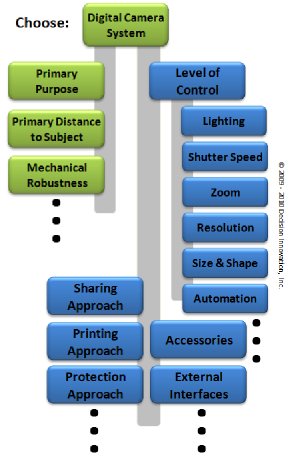Decide how you will use your pictures before making your digital camera selection
With over 3500 alternatives, making a digital camera selection can turn a fun decision into a major challenge. Unfortunately, digital camera comparisons can fail to consider some of the key criteria and related decisions that should influence your camera choice due to their limited focus on cameras' features and functions.
With all these possibilities, where do you start?
 The place to start is with some thought on how you plan to use your pictures. After all, the camera is just a means to an end (remembering an event, a place, a special person, or...). Here is a list of items to consider when making your digital camera selection.
The place to start is with some thought on how you plan to use your pictures. After all, the camera is just a means to an end (remembering an event, a place, a special person, or...). Here is a list of items to consider when making your digital camera selection.
- How will you use your camera and how often?
- Casual use (a few pictures a week)
- Personal use (always ready for a picture, 1-10 pictures daily)
- Amateur Photographer (once a week, 10-100 pictures)
- Professional photographer (daily, 50-2000 pictures)

- What type of pictures will you take?
- Very close to subject (less than 12 inches)
- Mostly close-ups of people or other objects
- Mostly Scenery
- Mixture of both close-ups and scenery
- When you take pictures, what level of control do you want?
- Lighting
- Shutter speed
- Range of distances from target that can be handled
- Picture resolution
- Picture size and shape
- Automated assistance (image stabilization, smile detection, ...)
- How do you want to print your pictures?
- Home printer
- In store service
- Online service
- On other items (greeting cards, T-shirts,...)
- How will you transfer and display pictures to other devices?
- Computer
- Cell phone
- Online (Personal website, Flickr, ...)
- Digital picture frame
- Television
- How will you manage your pictures?
- Label and categorize
- Geotagging
- Save, store and find
- Modify and edit
- Protect and preserve
- How will you maintain your camera?
- Charger
- Warranty
- Extended warranty or protection plan
- What accessories are needed for the pictures and experience you want?
- Camera case
- External flash or lighting
- Additional lenses
- Photographic filters
- Tripod
Use the list of questions above to reduce the available choices
You can use the previous list of questions to help quickly reduce the number of alternatives for your digital camera selection. You need to first decide which of the items listed is most important. This will ensure that you don't prematurely eliminate a desirable alternative as you continue to reduce the options to consider.
It is probably best to start by making decisions that characterize your intended use or purpose for your camera and type of pictures as suggested in the first two questions. This could easily reduce the available alternatives by a factor of four but ensure that the remaining choices will give you satisfaction when you use your camera. Be careful of using camera megapixel or price for early elimination. These are criteria that can be used later to finalize your choice among a small set of candidates that will deliver on your desired experience. Why buy a cheap camera that creates poor pictures and is no fun or too hard to use?
Now is the time to consider the related decisions
 Why consider all of this now? If you have a budget, now is the time to get a good understanding of what you might spend to get the picture taking experience you want. You don't want to find out after you buy your camera that you need a computer to process your pictures in the most convenient way. Also, if you have a computer, does it have the interface you need to transfer your pictures? Will your camera software run on your computer? You don't want to get home with a $200+ camera and find out you won't be able to use it with your computer.
Why consider all of this now? If you have a budget, now is the time to get a good understanding of what you might spend to get the picture taking experience you want. You don't want to find out after you buy your camera that you need a computer to process your pictures in the most convenient way. Also, if you have a computer, does it have the interface you need to transfer your pictures? Will your camera software run on your computer? You don't want to get home with a $200+ camera and find out you won't be able to use it with your computer.
Recognize that your digital camera selection sits in a network of related decisions that you have already made or may need to make in the future. A little thought now can prevent a lot of disappointment in the future.
Choose a strategy for protecting your memories
I have pictures of my grandparents that are over 60 years old. They are saved in a very simple system: a box in the basement. They were given to me by my parents who received them from their parents. It's amazing that they still exist, but despite a very crude and simple system, there are some amazing memories that I still have access to in that box in the basement.
The digital camera opens a whole new set of possibilities and risks in maintaining those memories for your children and grandchildren. With digital cameras, you could find yourself taking a hundred times the number of pictures taken in the past. Your pictures will likely be better, cover more events, and be easier and less costly to share. At the same time, a single hard disk failure or lost memory card can lead to a loss of valuable memories that will be impossible to replace. It's hard to imagine the number of pictures that have never made it off a cell phone due to a hard to use interface to a computer.
Develop your picture protection strategy before finalizing a digital camera selection, and you can avoid the hard lesson of losing a few years of photos in a fatal hard disk failure.
Ready for the digital camera comparisons?
With some decisions in hand on how you will use your camera, what kind of pictures you plan to take, and how you will manage your pictures, you will be ready to use some online product comparison tools to reduce your candidate list. Use your focusing decisions to provide required constraints (minimum needs) for the relevant product features. Any good product comparison tool will allow you to choose how you intend to use your camera. Watch out for megapixel selection. More is not always better, and you really want the lowest number of megapixels that will meet your resolution needs.
Some of your picture management decisions will help determine the minimum interface requirements for your digital camera selection. Fortunately, competition and standards are making it so most cameras will have the minimum interfaces you need.
Toward the end of this process you can use your budget to reduce your list to four to ten candidates. Finally, you will likely need to visit the product or store websites to confirm that the candidate cameras' software features will address your picture management requirements and that warranties are sufficient.
It's not just a digital camera selection ...
Watch out for the hidden decisions and consequences. You can use the power of a decision network to reveal the decisions and consequences that are not apparent on the surface. Doing this will increase your level of satisfaction and avoid unexpected costs and potential loss of precious memories that are captured by your digital pictures.
Return from Digital Camera Selection to Consumer Decision Making

